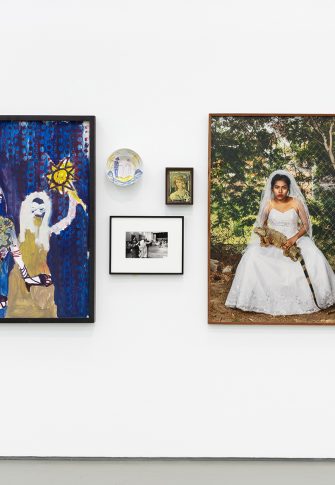Stevenson
27.08 - 30.09.2022
In a terse yet polite conversation spanning the different time zones of South Africa and New Zealand, Ruth Ige and I discuss her latest body of work. Ruth insists that the work is about freedom. I flinch from the other side of the large expanse of water that divides us. How do I convey that freedom is, for me, that impossible dream; that, in the words of Svetlana Alexievich, “Freedom needs free people, which we are not.” But perhaps, that is precisely what is at stake. Ruth Ige gestures towards the dream because it is precisely through the dream that freedom – in all its dogged, foreboding reticence – can be accessed. And that is where we find each other – in the lucid space of Freedom’s recurring dream.
Despite the dream’s elusiveness within the complex yet banal system of meaning making, dreams still offer immense mnemonic, heuristic and aesthetic potential. For the Philosopher J.W Dunne, who inspired Vladimir Nabokov’s foray into the world of dreams, they are not so much an apprehension of a past buried in the unconscious, but the perception of future events owing to the fact that time itself is not unidirectional but multiple and recursive.1J.W. Dunne (1958) Experiments With Time, London, Faber and Faber. For Gennady Barabtarlo, the author who compiled the notes of Vladimir Nabokov’s own experimentation with dreams into the expansive and lucid text, ‘Insomniac Dreams: Experiments with Time,’ “our dreams are not merely kaleidoscopic shards, jumbled, and mislabelled fragments of past impressions, but may also be a proleptic view of an event to come.”2V. Nabokov (2018) Insomniac Dreams: Experiments with Time, ed. G. Barabtarlo, Princeton University Press. On this account, they may very well be, as Ruth Ige shows us, the substrate on which the chimeric seeds of liberation are sown.
Ruth Ige is a Nigerian-born artist currently based in New Zealand. Her first solo exhibition at the Stevenson Gallery in Johannesburg is titled Freedom’s recurring dream. It is a series of portraits that figure freedom’s dream as a mothering entity that wades through the watery ether of blackness, historical and yet to come.
Ige’s work allows me to wade through the waters of my own longing. It offers – through rich visual language, expansive blue scenes, spectral figurations – a painting of freedom as beautiful and possible. It fashions a freedom dream that is eloquent and expansive, reaching towards the lost children of the black diaspora.
Ruth Ige’s blue scenes are mosaic in their presentation of the multiple shades of our innermost desires, our memories, the fictions we tell ourselves to get through the day, our losses but ultimately our utopian desire for a future markedly different from the now. They are rich with the cinematic language that elucidates just how slippery the blackness of blackness is – think Tarell Alvin Mcraney’s play In Moonlight Black Boys Look Blue, adapted into the Academy Award winning film Moonlight.
What flashes through my mind is Nijah Cunningham Tiana Reid’s invocation of the penal and carceral logics that sustain anti-blackness through their assertion, “blue is the coldest colour.” At stake for McCraney, Cunningham Reid and ultimately Ruth Ige is the figurative and psychic hold blue has over the arts and aesthetics of blackness, which is foretold by the longstanding musical traditions of Blues, which Clyde Woods3C. Woods (2007) “‘Sittin’ on Top of the World,’ The Challenges of Blues and Hip Hop Geography,” Black Geographies and the Politics of Place, Between the Lines. refers to as an antithesis of the plantation and its psychic and affective geographies.
In the aesthetics of the black radical tradition, dreams tether themselves to both water and the black maternal. Take, for instance, Kamau Brathwaite whose poem Kumina works through this triad. In the wake of the loss of her son, Kamau’s first person speaker laments, “I am unhappy like the wind and tides are restless rivers, I can’t find you, I can’t find you, I cannot cannot cannot be consoled to dreams.”4K.E. Brathwaite, (2005) “Kumina,” Born to Slow Horses, Wesleyan University Press.
Like Brathwaite, Ige’s paintings work through the poetics of black sorrow and grief and their imaginative landscapes. Her tapestries contour the chimeric figure of freedom and the structures of injustice that make it the ever elusive ideal. Swathes of blue haunt the canvas, unleashing a torrent of grief, memory, foreboding, longing and playful abstraction. This is both light and heavy with water5E. Deloughrey (2010) Heavy Waters: Waste and Atlantic Modernity, The Modern Language Association of America and its symbolic repertoires. Shades of cobalt and French blue and midnight blue robe freedom’s dreams, presenting a ghostly image that makes murky the waters of our collective psyche.
Thus, these artworks remind us that water makes for a cogent mnemonic apparatus. To this effect, Toni Morrison writes that “all water has a perfect memory and is forever trying to get back to where it was.” Water, like memory, is also always carving new paths for itself. It is always resisting constraint. As an oceanic force, it washes new memories to our shores; as a river, it threatens to erode the banks of our clandestine lives; as discrete pools it hides its own depth. Ige’s vividly blue renderings embody the equanimity of water. They lead us towards water’s violent, vacillating and visceral symbolic significance. They suggest that it is precisely water’s violence that births its emancipatory potential. The blue watery dream is the birthing of a diasporic consciousness, a conduit, a substrate that beckons us towards freedom.










